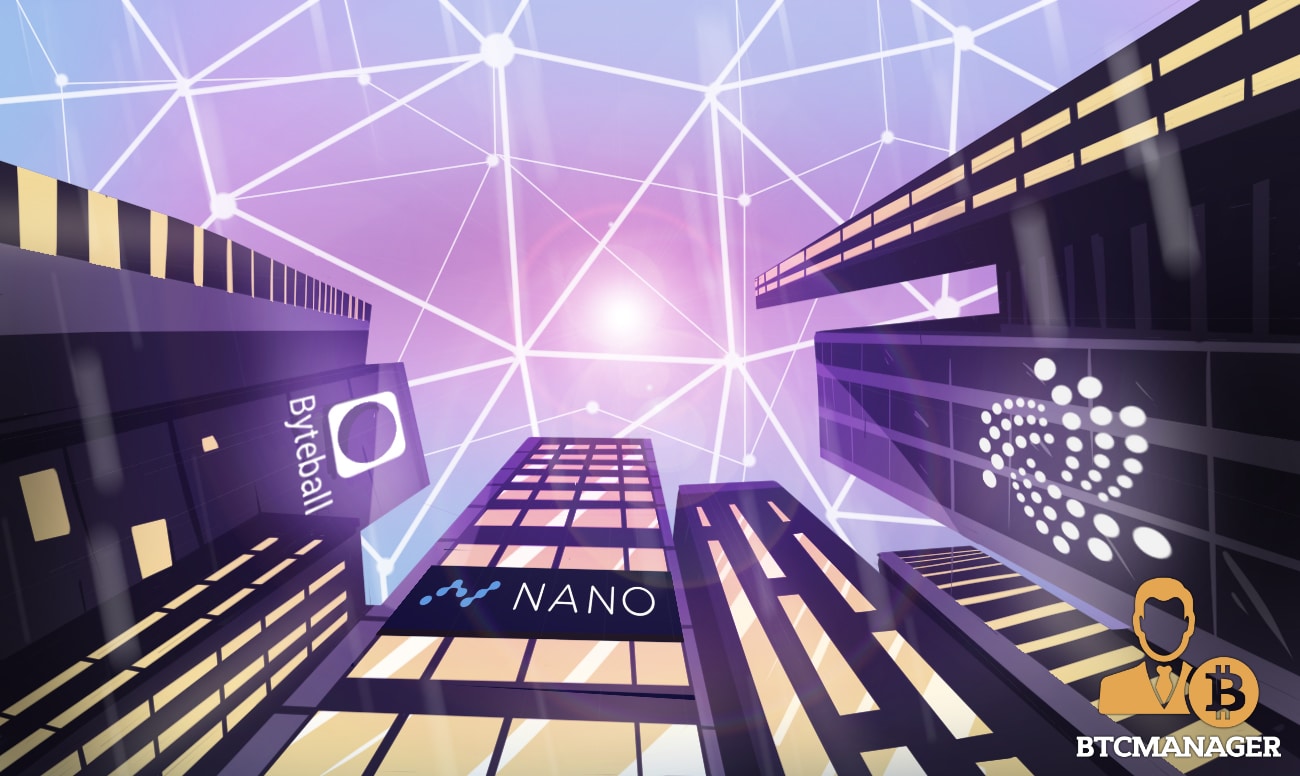DAG Smart City Revolution – How NANO, IOTA, Byteball and Cybervein Could Play a Role

The city of the future is envisioned as using many types of electronic data collection sensors to supply information for managing assets and resources efficiently. While blockchains provide a significant foundation in this regard, the yet-obscure Directed Acyclic Graphs (DAG) technology is primed to play a crucial role.
The Smart City
In a smart city, blockchain systems will be used where sensitive personal data or highly valuable intelligence are managed by digital infrastructures that can physically link dispersed sensors, devices, machines, which exchange information in real time.
As stated by Open Access Government, the challenge will have two distinct facets. First, to ensure that the huge volumes of data created by smart cities remain safe. Second, to ensure there is the digital infrastructure in place to cope with this complex and diverse web of applications, data, content, clouds, networks, and people.
A research paper by PwC concluded the undeniable interest in building such an ecosystem by governments around the globe, including emerging and developed economies. Several countries have already created strategies to metamorph their landscapes into sensor-enabled, data-analyzing, urban-information centers. As stated in the report, smart cities “enable operational efficiencies, maximise environmental sustainability efforts and create new citizen services.”
The Need for DAG
The past years have seen great developments in the creation and adoption of smartphones, smart homes, and even smart cars, with the demand undoubtedly spearheaded by the millennial. However, large cities would require several databases.
For platforms that require high throughput of data, DAGs are a game changer. Some of the most popular cryptocurrency projects in 2017-18 have, in fact, utilized a DAG-based approach instead of using a blockchain.
To expand on the abbreviation, the DAG stands for Directed – the connections between the nodes (edges) have a direction – Acyclic – “non-circular” – moving from node to node by following the edges, you will never encounter the same node for the second time – Graph – structure consisting of nodes, that are connected with edges.
The DAG technology has, in recent years, been utilized to solve issues on data routing, processing, compression, and scheduling.
In theory, the fundamentals allow the DAG protocol to connect multiple IoT systems comprising thousands of data points to sensors in cars, offices, homes, and anywhere else where large amounts of quantifiable information are produced.
In certain domains, like scientific research or other in-depth combinations of research, use of a blockchain may prove to be redundant and invasive.
Furthermore, if miners or system participants were to be incentivized for confirming every transaction or set of transmitted information, the high fees would surge to the point of users choosing an alternative, cheaper, traditional business processes.
However, while AI and IoT are part of a disruptive micro-ecosystem, blockchain and DAG projects visualize a macroeconomic influence for their applications.
The DAG Disruptors
The current DAG favorites, in terms of cryptocurrency projects, are Iota, Byteball, NANO, and Cybervein – each with different use-cases and ideological approaches.
Germany-based Iota Foundation (IOTA) aims to connect devices through “verification transactional settlements that incentivize devices to share their properties and data in real time.” The product merges DAG-based decentralized databases and IoT-connected devices to form value chains and general applications. A small part of its use-case also involves lending extra computing power to data centers in exchange of a cryptographic incentive.
In February 2018, BTCManager reported Iota’s impressive partnership with Taipei, the capital of Taiwan. As per details, the Far Eastern city is to implement Iota’s Tangle protocol into its projects, including smart citizen I.Ds and roadside parking.
Taipei municipality and the IOTA Foundation teams up on Taipei's Smart City Living Lab initiative together with @biilabsrocks to make Taiwan's capital a leading smart city.#IOTA #smartcity pic.twitter.com/mS8M0O5Kxa
— IOTA (@iota) January 30, 2018
Byteball and NANO are payment-focused DAG projects. While the latter promises instantaneous, zero-fee transactions via its innovative block lattice structure, the former utilizes smart contracts to ensure cryptocurrency, bonds, and equities settlements via a chat application.
By implementing the DAG technology, Byteball (GBYTE) allows all users to “secure each other’s data by referencing earlier data units created by other users, and removes scalability limits common for blockchains.”
Nano (NANO) provides accounts to run their own blockchain as part of a larger directed acyclic graph. Each individual user provides the computational power for the verification of their own transactions, meaning entire network is not required to update the ledger together in massive blocks.
Cybervein (CVT) takes a broader approach towards its DAG-based product and is closest to building a smart city. The project develops a universal network of decentralized and immutable databases on which data can be stored, professionally processed, shared and monetized.
A fully-functioning smart city will process massive amounts of data in short periods while ensuring its safety. In this regard, the Cybervein protocol ensures the prevention of unauthorized access or alterations to sensitive databases, while incentivizing the sharing of data between the interconnected, yet independent, public or private databases.
Cryptocurrencies and Smart Cities
While currently used administrative frameworks perform reasonably, they are far too centralized to propel the smart economy as a whole. Additionally, the problem of privacy looms in today’s digital infrastructures.
To elaborate, the internet is an easy place to copy one’s identity. Think Facebook accounts or Drivers Licenses or India’s Aadhar Card breach, the internet is not the final frontier.
Using the immutability of a blockchain, the rigidity of a smart contract, the privacy of a cryptocurrency, and the data-processing prowess of DAG technology, the smart city may utilize these distinct protocols to function, develop, and sustain.
Cities have started their experimentations already. Slovenia, a small, oft-ignored Eastern European country, announced in June 2018 the launch of BTC City, a corporate shopping center that accepts only cryptocurrencies and handles its data management on the blockchain.
While a shopping mall is no match for a city, it does provide a litmus test for cryptocurrencies and blockchains in a controlled micro-economy.













